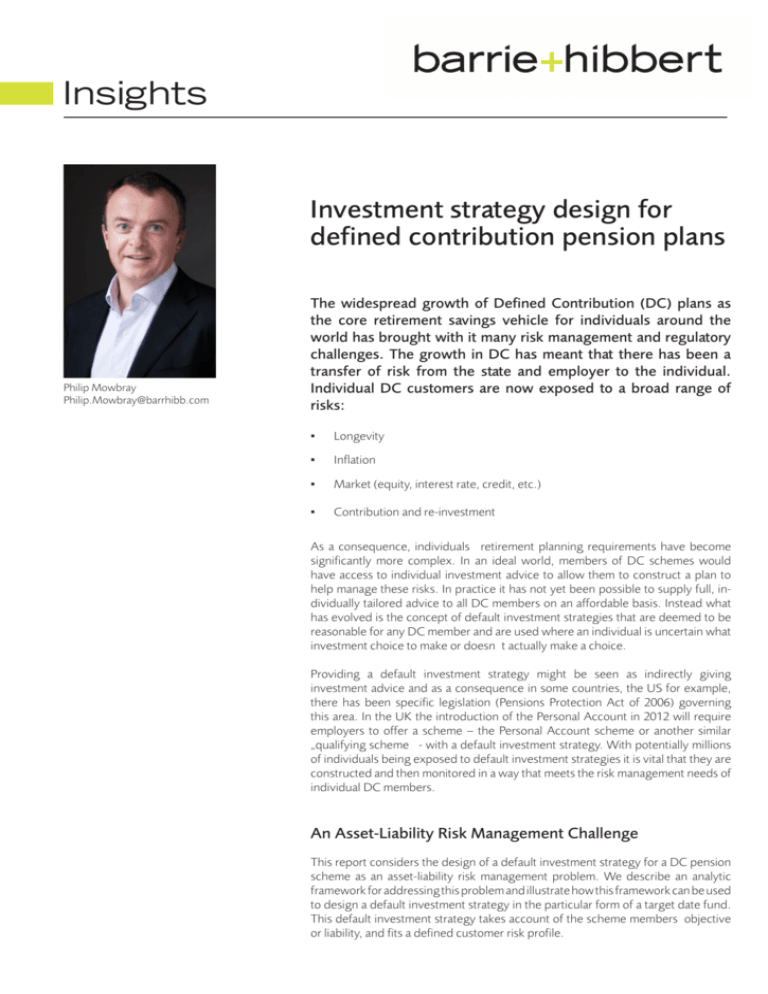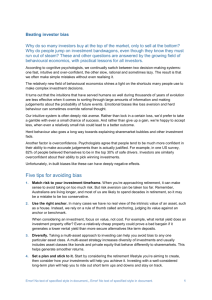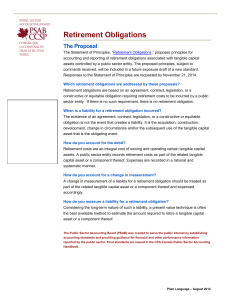
Insights
Investment strategy design for
defined contribution pension plans
Philip Mowbray
Philip.Mowbray@barrhibb.com
The widespread growth of Defined Contribution (DC) plans as
the core retirement savings vehicle for individuals around the
world has brought with it many risk management and regulatory
challenges. The growth in DC has meant that there has been a
transfer of risk from the state and employer to the individual.
Individual DC customers are now exposed to a broad range of
risks:
▪▪
Longevity
▪▪
Inflation
▪▪
Market (equity, interest rate, credit, etc.)
▪▪
Contribution and re-investment
As a consequence, individuals‟ retirement planning requirements have become
significantly more complex. In an ideal world, members of DC schemes would
have access to individual investment advice to allow them to construct a plan to
help manage these risks. In practice it has not yet been possible to supply full, individually tailored advice to all DC members on an affordable basis. Instead what
has evolved is the concept of default investment strategies that are deemed to be
reasonable for any DC member and are used where an individual is uncertain what
investment choice to make or doesn‟t actually make a choice.
Providing a default investment strategy might be seen as indirectly giving
investment advice and as a consequence in some countries, the US for example,
there has been specific legislation (Pensions Protection Act of 2006) governing
this area. In the UK the introduction of the Personal Account in 2012 will require
employers to offer a scheme – the Personal Account scheme or another similar
„qualifying scheme‟ - with a default investment strategy. With potentially millions
of individuals being exposed to default investment strategies it is vital that they are
constructed and then monitored in a way that meets the risk management needs of
individual DC members.
An Asset-Liability Risk Management Challenge
This report considers the design of a default investment strategy for a DC pension
scheme as an asset-liability risk management problem. We describe an analytic
framework for addressing this problem and illustrate how this framework can be used
to design a default investment strategy in the particular form of a target date fund.
This default investment strategy takes account of the scheme members‟objective
or liability, and fits a defined customer risk profile.
Identifying the customer liability for a DC member is a significant challenge as
a large number of assumptions need to be made – the following list is not
exhaustive:
+
+
+
+
+
+
+
+
+
+
Current age and intended retirement age
Target or expected retirement income
Current pension fund value
Future contribution payments (employer and employee)
Range of available investment assets
Risk tolerance or risk profile
Longevity assumptions, including future longevity improvements
Annuity income basis (eg. fixed or index-linked) and cost margin
Spouses benefit
Salary at retirement
Ideally the above assumptions would be specified at the individual scheme
member level. Unfortunately, this is not always an economically viable option.
To make decisions easier for the individual scheme members, or to support
specific pension legislation such as Personal Accounts, the concept of default
investment strategies have become very popular. These strategies take into
account the various risks inherent in the assets and liabilities of a DC scheme
and attempt to provide an approach to investment that is generally appropriate
to a defined group of DC members who are similar in respect of the above
characteristics, rather than to specific individuals.
Risk tolerance and remaining term to retirement are the most common
characteristics used to distinguish groups of DC scheme members. Default
funds are often designed with embedded asset allocation strategies that
manage the investments over time and in accordance with a defined customer
risk profile.
In terms of the other variables such as contribution payments and annuity
pricing basis, fixed assumptions usually need to be made in order to define the
liability for the typical scheme member.
In the following section, we investigate definitions for the liability and for
measures of risk and return in relation to this liability, which are appropriate for
use in constructing default investment strategies for DC pensions.
Defining the DC Scheme Liability
For the purposes of the illustrative case study in this report, we will assume the
liability is the provision of an index linked income starting at retirement, where
the scheme member is interested in the future income level expressed in real
terms.
We will assume that our „default‟ scheme member plans to make regular
contributions at a fixed proportion of salary. Salary is assumed to increase in
line with inflation between today and the planned retirement date, with no
employment breaks.
The presence of these contributions, or „liability cashflows‟, means that the
value of the pension fund at retirement and the level of retirement income that
this will buy depends not only on the total investment return over the
accumulation phase, but realised path of returns throughout the accumulation
phase. As an individual‟s fund value grows relative to their expected future
contributions, their potential for large losses which cannot be replaced by
future contributions increases. This path dependency becomes a very
important factor in the design of default investment strategies for DC pension
schemes.
From the above discussion, it is clear that the analytic framework used to
design robust liability-based default funds needs to take into account the paths
of asset returns throughout the accumulation (contribution) phase, and also
the relationship between these asset returns and the value of the liability.
Modelling the DC Scheme Liability: Liability Matching Portfolio
In order to address the issues described above, we have used a stochastic
asset model. A stochastic asset model (ESG) has the ability to capture the
distributions and correlations of the paths of economic risk drivers in an
integrated framework. It can also produce outputs which allow us to define
and measure risk in the same terms as those used by a typical DC pension
scheme member.
We can use this modelling framework to simulate changes in the value of the
DC scheme member liability over the term to retirement. The initial stage in
the liability analysis is to identify a portfolio of assets that closely matches
movements in the liability. If this portfolio exactly matches movements in the
liabilities, then we will fix the future retirement income exactly and would have
a risk-free investment strategy, or a Liability Matching Portfolio (LMP).
However, practical issues mean that finding an exact LMP is usually not
possible because:
+
+
Appropriate assets may not exist in a cost-effective or tradable form.
The DC scheme member liability (final retirement income) is
dependent on the price at which assets can be bought using future
contributions. Since future asset prices are uncertain, and since most
DC scheme members will be unable to borrow against future earnings,
the scheme member is exposed to re-investment risk which cannot be
hedged through replicating assets.
For our defined DC scheme liability, the theoretical Liability Matching Portfolio
(LMP) would consist of a portfolio of zero-coupon government bonds with
maturities matched to future earnings (i.e. borrowings against future
earnings), plus a portfolio of zero-coupon index-linked government bonds
with maturities matched to retirement income cashflows.
Importantly, this LMP represents a “risk-free” investment, relative to the
defined liability. As such, it provides an objective benchmark against which a
DC scheme member can measure risk and return.
Constructing DC Investment Strategies: Least Risk Portfolio
Since it will not usually be possible to find an exact LMP, instead we need to
identify a portfolio of tradable assets which gives a reasonable approximation
to movements in the scheme member liability. In the remainder of this
document we will distinguish between the theoretical Liability Matching
Portfolio (LMP) and an investable „Least Risk Portfolio‟ (LRP).
The Least Risk Portfolio (LRP) provides the foundation for establishing default
investment strategies, being the investable asset portfolio which best
approximates to the theoretical LMP and minimizes risk relative to the scheme
member‟s liability.
For the defined DC scheme liability in this report, we will assume the LRP is a
portfolio of zero coupon index-linked government bonds with maturities
which are matched to the expected retirement income cashflows. Although
the presence of re-investment risk means this LRP is not “risk-free”, it provides
the lowest risk investable asset available to the DC investor.
Exhibit 1
Combining risky assets with a liability-matched “LRP” gives a
better outcome than an asset only solution.
By combining the LRP with other risky assets (e.g. UK Equity) we will increase
the level of risk, with the objective of increasing the projected or expected
final retirement income. For the purposes of illustration in this report, we will
assume that our DC investment strategy will consist of an allocation to the LRP
plus an allocation to a single risky asset, a diversified equity portfolio.
Exhibit 1 emphasises the importance of a liability-based approach to designing
an investment strategy for DC pension schemes. The risk and return
characteristics of LRP-based strategies are compared with conventional „assetonly‟ mean-variance efficient portfolios. In both cases, the lines represent a
range of portfolios from 100% LRP/Cash to 100% Equity. This shows that, for a
customer whose liability is defined in terms of retirement income level, the
LRP-based portfolios deliver the same level of “return” (retirement income) for
significantly less risk.
Constructing the Default Investment Strategy
In designing a default investment strategy for a DC scheme, our aim is to
introduce risky assets to the LRP in order to match the risk profile and return
expectations of the „default‟ DC scheme member. In order to do that, we need
to be able to define the default risk profile in measurable terms.
Defining Appropriate Measures of Risk and Return
For typical DC scheme members, the most logical measure of „return‟ is the
salary replacement value of the annuity that will be purchased at retirement
(percentage of final salary).
Pension investors are likely to need to accept some risk, due to not being able
to invest in a risk free portfolio to match the liability or because they would like
a greater income in retirement.
To capture this risk and to understand how much risk the customer is willing to
accept, there are a wide range of possible risk measures we can use:
+
+
+
Volatility: This measures the average dispersion of the return.
Value at Risk (VaR): This only tells the value of a particular point in the
tail of the return distribution, not how long the tail is, i.e. “How bad
can it get?”
Expected Shortfall: The expected shortfall in return multiplied by the
probability of that shortfall.
To evaluate the risk/return trade-off, particularly when including additional
“risky” assets, members will be concerned about the potential for future
retirement income shortfall relative to the “risk-free” investment option (i.e.
the Liability Matching Portfolio), and also with the size of this potential
shortfall.
As such, Expected Shortfall has been used as the risk basis for designing
investment strategies in the example given in this Insight report. However, the
stochastic ALM framework is flexible enough to allow any choice of risk
measure.
Specifying Customer Risk Profile
In order to construct an investment strategy, we need to define a risk profile in
terms of our chosen risk measure. This risk profile tells us how much risk the
individual is willing to accept at each stage during the accumulation phase of
their pension savings plan.
For most DC pension scheme members their risk profile will reduce as they
approach retirement. This is because, as DC scheme members get older and
pay contributions into their pension plan, they accumulate financial wealth in
place of diminishing human capital. Roughly, human capital can be defined as
the present value of expected future earnings. As the scheme member
approaches retirement, their ability to use human capital or adjust
consumption to offset financial market shocks becomes significantly
diminished.
The level and shape of the default risk profile is fundamental to the design of
the default investment strategy. As an example (and used in the rest of this
report) we could define a target risk profile based on Expected Shortfall in final
salary replacement level, that varies linearly with term to retirement at age 65.
+
+
+
At age 50 the „default‟ (male) scheme member is willing to accept an
Expected Shortfall in Final Salary Replacement of 14%.
By the time he reaches age 60, this has fallen to 4%.
By age 64, in the final year before retirement, this has fallen to 0%; at
that stage, the „default‟ scheme member would like to have complete
certainty about his index-linked income in retirement.
This typical default profile is the rationale behind the popularity of many
lifestyle investment strategies or target date funds. To match this form of risk
profile, these approaches identify an asset allocation which changes over
successive investment periods prior to retirement; an asset allocation glide
path.
It is important to note though that different levels and shapes of risk profile will
give very different asset allocation glide paths
Constructing Investment Strategies or ‘Glide-paths’
Once we have defined the liability proxy (LRP), have quantified the risk profile
and defined the universe of investable assets, we can use the stochastic
modelling framework to construct asset allocation glide-paths.
Consider the following example scheme member:
Exhibit 2
Fitted Asset Allocation Glide Path
(% Allocation to “Risky” Asset)
+
+
+
+
+
+
+
+
Male, aged 50
Retiring at age 65
Currently pension fund size £90,000
Salary of £30,000 pa, expected to increase in line with inflation
Invests 8% of his annual salary into the default investment strategy
Has no other assets to fund his retirement
Has a linear risk profile described earlier
Invests in the LRP and a portfolio of diversified equities
Exhibit 2 shows the resultant asset allocation glide path that matches the risk
profile in terms of the changing asset allocation between the LRP asset and a
risky diversified equity portfolio.
Of course, the rationale for the default scheme member adopting a “risky”
additional risky asset exposure increases the expected return (i.e. the
expected retirement income level), while accounting for the customer‟s stated
risk profile.
To understand the extent to which this additional risk exposure generates a
better expected return, we have compared the distribution of retirement
income under the „Least Risk Portfolio‟ with that generated by the fitted asset
allocation glide-path, for the example scheme member.
Exhibit 3
Comparing Risk and Return: Least Risk
Portfolio vs. Fitted (Risky) Glide Path
There are several observations to be made regarding the results in Exhibit 3:
+
+
+
Perhaps the first is that the so-called “Least Risk Portfolio” still has a
significant amount of risk, in terms of the final retirement income level.
Although the median salary replacement rate is about 21% there is a
10% chance this falls outside the range 15% - 30%.
Secondly, by investing in the default asset allocation glide-path, the
median Salary Replacement level is significantly higher at approx.
24%. Furthermore, there is around a 1 in 4 chance that this could
exceed 33%. The retiree has a reasonable chance of a higher
retirement income than under the LRP.
Finally, we can see that the additional risk under the default asset
allocation glide-path is relatively limited, in very extreme cases (e.g. 1
in 100), the Salary Replacement Rate could fall to as low as 10%.
Conclusion
As DC pension schemes increasingly replace traditional DB provision,
individual investors become increasingly responsible for understanding and
controlling risk in their pension savings plans. At the same time, many DC
scheme members are likely to have very limited knowledge and understanding
of investment and risk; employers and pension product manufacturers who fail
to offer well-designed DC investment solutions are becoming exposed to
significant and growing compliance and reputational risk.
The use of an appropriate stochastic asset-liability modelling solution is the
most sensible approach to capturing the path-dependency and risk profiles
relevant to DC pension investors. This Insight report has described a coherent
framework for applying stochastic asset modelling to the design and review
default risk-based investment strategies for DC pension schemes.
Disclaimer
Copyright 2009 Barrie & Hibbert Limited. All rights reserved. Reproduction in whole
or in part is prohibited except by prior written permission of Barrie & Hibbert Limited
(SC157210) registered in Scotland at 7 Exchange Crescent, Conference Square,
Edinburgh EH3 8RD.
The information in this document is believed to be correct but cannot be guaranteed.
All opinions and estimates included in this document constitute our judgment as of the
date indicated and are subject to change without notice. Any opinions expressed do
not constitute any form of advice (including legal, tax and/or investment advice).
This document is intended for information purposes only and is not intended as an
offer or recommendation to buy or sell securities. The Barrie & Hibbert group excludes
all liability howsoever arising (other than liability which may not be limited or excluded
at law) to any party for any loss resulting from any action taken as a result of the
information provided in this document. The Barrie & Hibbert group, its clients and
officers may have a position or engage in transactions in any of the securities
mentioned.
Barrie & Hibbert Inc. and Barrie & Hibbert Asia Limited (company number 1240846)
are both wholly owned subsidiaries of Barrie & Hibbert Limited.







